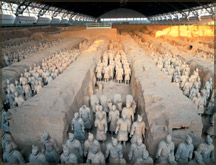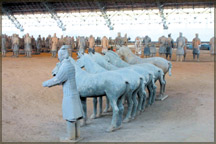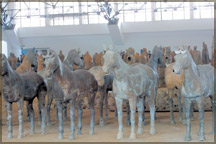|
DAILY NEWS ONLINE |
|
|
|
OTHER EDITIONS |
|
|
|
|
|
|
|
|
|
OTHER LINKS |
|
|
|
|
|
|
  |
|
They call it the eighth wonder of the worldAn extraordinary archaeological site, which has now become a sight no visitor to China could afford to miss, lies in Shaanxi province, China. This is known as "The Terra Cotta Warriors and Horses" and is supposed to be over 2200 years old.
Chinese people call it the eighth wonder of the world. They have their reasons to confer that honour. On September 23rd 1978, the Prime Minister of France went to the Museum of the Terra Cotta Warriors and Horses, during its construction. Standing in the No. 1 tunnel and facing the graceful underground array, he said: "Not having seen the pyramid, means you haven't really been to Egypt; not having seen the Warriors and Horses means you haven't really been to China... There're seven wonders in the world, and here is the 8th." These words stirred the world. "The 8th wonder of the world" almost became another name of the Terra Cotta Warriors and Horses. The magnificent work belongs to a Chinese Emperor - Qin Shi Huang.
Who is this Qin Shi Huang? In 247 BC, a thirteen-year-old prince by the name of Ying Zheng ascended the throne of Qin (Ch'in) after his father died. Within twelve years his armies had crushed most of the neighbouring states. He had one overriding goal: To unify the country. It had never been done before. China was a land of contrasts then as it is now. From arid desert to waterfalls, from "stone forests" to fragile flowers alongside the Great Wall, the country and the landscape are diverse. Its ancient music was beautifully haunting. China had been in a period of turmoil for over 200 years at the time when Emperor Qin assumed power. This period was known as the Warring States Period. Prior to the Warring States Period, China was divided into hundreds of small kingdoms and fiefdoms, this was known as the Spring-Autumn period and lasted for several hundred years.
During the Warring States Period, seven dominant kingdoms emerged, these kingdoms were: Qin, Yan, Qi, Qu, Yan, Han, Zhao and Wei. Of these seven, Qin was the most powerful and ambitious. Having emerged from such a violent, tumultuous period, King Zheng's vision of a unified China was indeed sincere and was accepted by many as the official mandate from heaven. However, the violence used in the process of unification was fierce. He obviously made many enemies along the way. For the first time one state (Qin) exacted obedience from its neighbours. For the first time one man (Zheng) was in charge. For the first time the walls of the former independent states were linked together - and extended - to form the Great Wall. And, for the first time, China had an emperor. To commemorate his achievements, Ying Zheng took a new name. Believing what he did to unify the country surpassed the accomplishments of other ancient rulers he used both of those names (Huang-Di) to create a new title: Emperor. Adding the name of his state, Ying Zheng became Qin Shi Huang-Di (pronounced "chin sher hwang- dee"). It means "The First Emperor," a title that lasted 2,000 years. As supreme feudal ruler, Shi Huang founded the Chinese imperial system and standardized Chinese writing, laws, coinage, weights and measures. He also imposed harsh laws and cruel punishment for those who disobeyed him. He ordered that the histories of all the former states except Qin [Ch'in], folk collections of poetry and articles and books by scholars of schools with views different from those of the Qin. However, books on medicine, agriculture, and copies of condemned books were preserved in the Imperial capital. Confucian scholars disapproved of the Emperor's methods - and said so in their commentaries, articles and poems. A year later he arrested some 400 Confucian scholars, the most active of whom had continued to attack him, and had them buried alive. Ancient sources report that burying people alive was an old practice among the Qin. Nearly 400,000 soldiers were killed in that fashion after Qin's defeat of Zhao in 260 BC. At the time, servants were also buried alive to ensure their masters received appropriate care and attention after death. Despite his ruthlessness, the first Emperor spared soldiers from a similar fate in his own tomb. Instead, about 700,000 workers over 36 years constructed his mausoleum and created thousands of life-size terra cotta soldiers to stand guard over Shi Huangdi after his death. For more than two thousand years, no one knew an entire army of terra cotta soldiers - in battle formation - were underground near the former imperial capital of Xi-an. These treasures were rediscovered in 1974 when farmers, digging a well, found three vaults filled with some of the most exciting archaeological finds of the 20th century. More than 6,000 soldiers plus a few horses and chariots were in the first pit. Initially archaeologists thought each terra cotta figure was unique, most likely patterned after real people. The second vault contained about 1,400 soldiers and cavalry while a third pit contained 68 officers. Experts now believe each figure was made from a variety of moulds which were assembled and covered with clay. Final details for each were carved. The terra cotta soldiers are remarkably realistic sculptures. The figures are mostly 1.8 meters (5 feet 11 inches) in height, the lower part of the body being solid and the upper part hollow. Originally the figures were painted in bright colours however, over the two thousand years they have silently stood guard, the colour has faded and worn off. The squeamish faces of the warriors feature broad foreheads and wide, thick-lipped mouths. Their eyes focus on the far distance and some bear an ornate hairstyle. The muscular horses have big bright eyes, large nostrils, stout legs and plump waists and hips and are poised ready to gallop. By filling his mausoleum with soldiers, Huangdi took great care to protect himself in the afterlife. His actions in burning books, however, greatly damaged the pursuit of knowledge both while he was alive and later. Even the books he ordered saved were eventually destroyed in the chaos following his death in 210 BC. Ancient sources tell us that life for workers during the Qin (Ch'in) dynasty was filled with misery. "The ditches were filled with corpses" of workers and "piled-up skeletons supported one another." Although the First Emperor said his dynasty would last 10,000 years, it ended (sparked by a worker's rebellion) shortly after his death. But the Great Wall (which took the lives of countless labourers) and the Terra Cotta soldiers (standing at attention 23 centuries later) remind us of a time when the word of one man resulted in the misery of so many. The Terracotta Warriors and Horses is a sensational archaeological find of all times. It has put Xian on the map for tourists. It was listed by UNESCO in 1987 as one of the world cultural heritages. |
|
|




